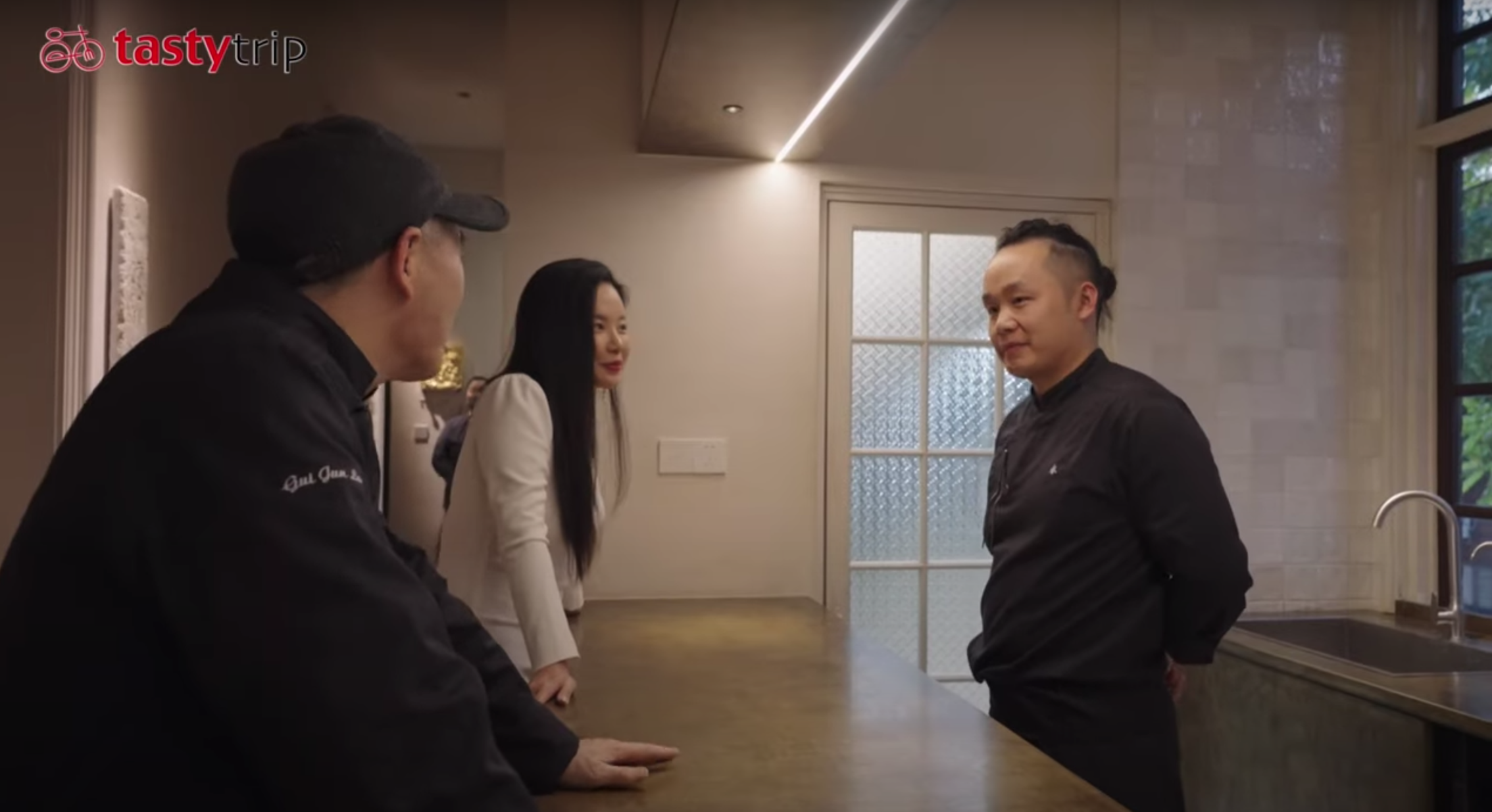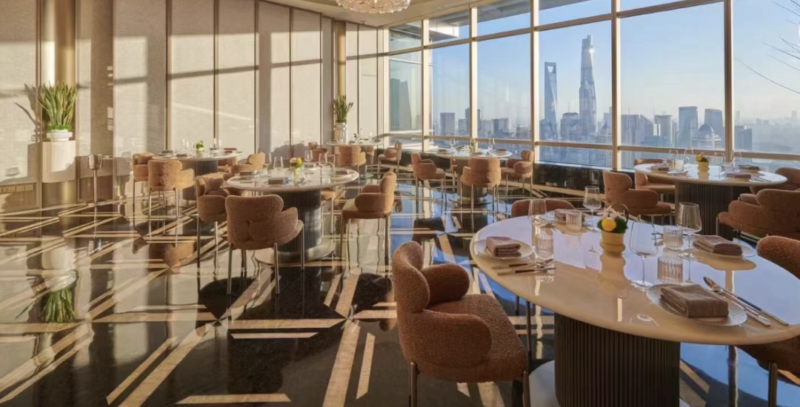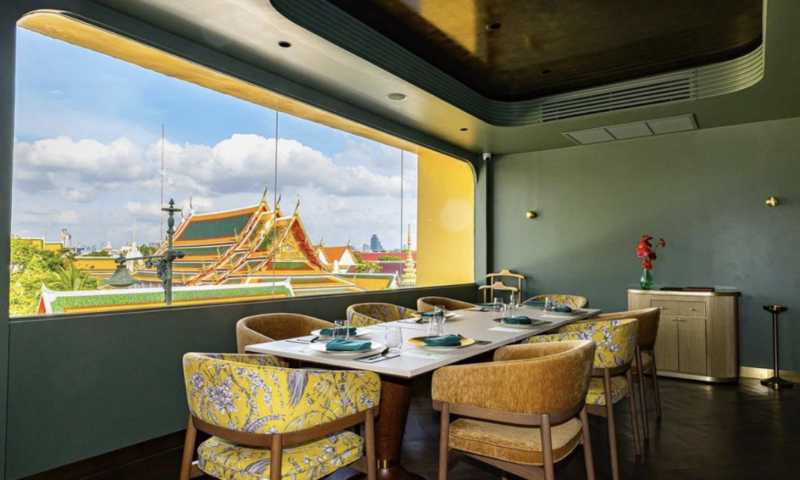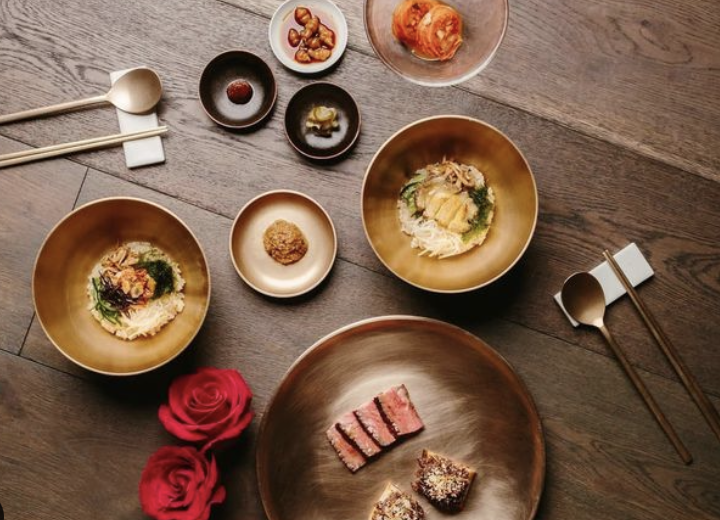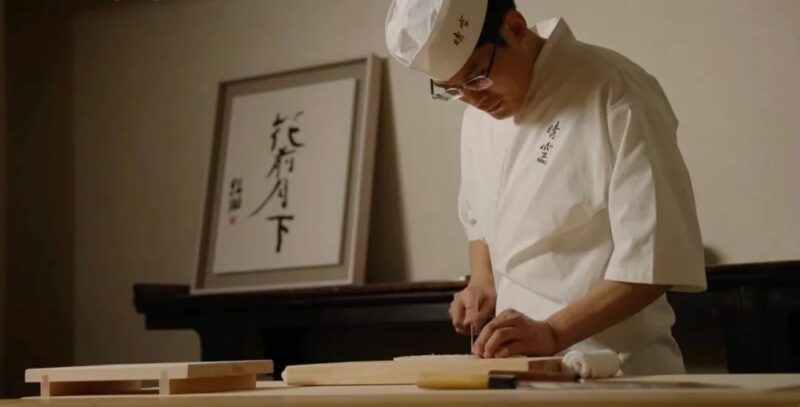The villa is a 1918 Republican building, acquired by restaurant owner and redesigned by a landscape architect. The original name Xi’an Garden has been retained, as well as its basic structure. Decorations were made to walls, the ceiling and flooring to fully reflect Chinese elements. The high ceiling of private dining rooms was applied a coat of gold leaf by a Macau-based master with 30 years’ experience, giving it a contemporary feel and even more stunning is the warm, soft glow created by partial lighting on the metallic surface adding a beautiful reflective quality to the room. A classical, serene ambience fills the space as guests profoundly admire at the owner’s collection of exquisite ceramics from Tang and Song dynasties.
Upon entering Yong, you can only marvel at the fact that there is a story to tell about each and every sight: the entrance door is made of golden phoebe nanmu wood; the stepping stone under the door is Ming Dynasty volcanic rock; the staircase is made of white marble from Qu Yang in Hebei province; the floor is made of granite from Hunan province. Each of the tables in the restaurant is varnished by a lacquering technique that involves natural drying of the coat which results in different patina on the surface due to varying weather conditions. Each table takes months to make. It’s truly eye-opening to see such an intensive and elaborate use of Chinese aesthetic in a restaurant.


There is a camphor tree in the front courtyard, surrounded by Guangzhou cherry trees. Imagine how romantic the courtyard would be during the flowering season. The restaurant’s private dining rooms take their names from the Lantingji Xu (or Preface to the Poems Collected from the Orchid Pavilion), a Chinese calligraphy masterpiece written by the well-known calligrapher Wang Xizhi from the Eastern Jin dynasty (317 – 420).
There are few restaurants in my knowledge that focus so much on Chinese aesthetic. The fusion of China’s rich history and aesthetic at Yong is also reflected in its cuisine, which, led by Master Lan and Head Chef Zhang Jian, features signature dishes from Yuzhilan Chengdu, as well as Chef Zhang’s personal creations.

The pre-meal tea is Roasted Mountain Oolong & Yunnan Crimson Rose, where rose pedals serenely float in the warm and mellow tea liquor, conveying the beauty of oriental tea rituals. Then, we have a small bowl of chestnut soup made from two different types of sweet chestnuts in season. A complex process of roasting, boiling and steaming is necessary to bring out the natural sweetness of the chestnuts, making it a perfect soup for a wet and cold winter day in Guangzhou.
Cold dishes are an important part in a Sichuan banquet. The following six cold plates are each impressive and together beautifully presented in a silver food box. Peppery Chicken with Scallion is a delightful dish made with deboned Qingyuan chicken thigh marinated with fresh peppercorns and ginger before being rolled and boiled in low heat and then chilled. The sauce is made with homemade red chilli oil, Sichuan green peppercorn and scallion. A local fare from Dazhou in Sichuan, the Crispy Shredded Beef is paper-thin, spicy and numbing. The Rose-infused Lanzhou Lily Bulbs have natural sweetness and are pleasantly refreshing.


Chicken Feet with Pickled Pepper by Master Chef Lan can be ordered here. Spiny Lobster with Five-colour Noodles is one of my favourite, which includes homemade five-colour noodles, crispy fried lobster tail and kung pao lobster. The plating of colourful noodles has upgraded; the lobster tail is deep-fried in Sichuan style until crispy and sprinkled with chili powder and rattan pepper powder, leaving a slightly tingling sensation between the lips; the lobster meat simmered in lobster broth is perfectly cooked a bit loose in the center and paired with a sweet and sour kung pao flavour sauce to complement its umami and freshness.

At Yong, dishes are served by calculating the total amount of food normally consumed by each diner and controlling how many ingredients should be allocated for each dish. This way, diners can enjoy the food without the worry of overeating. It would be difficult to achieve this with the usual Chinese style service (everyone helping themselves from the same dish).
After cold dishes, we are served Chef Lan’s signature dish – Golden Thread Noodles. The noodles are as thin as silver needles, and the rich, full-bodied soup base inspired from Steamed Chinese Cabbage in Supreme Soup is more like a French consommé. It’s a kongfu dish that requires masterful knife skills. I can imagine the effort Head Chef Zhang Jian has paid to grasp Master Lan’s techniques.
Spiny lobster, shrimps and black tiger prawns are stewed together to produce a thick, gelatinous soup before being cooled down and solidified into a tantalizing prawn jelly. A selection of 12-year Russian sturgeon caviar is added to enhance the umami of the soup through fermented flavours. Pine nuts are garnished on top and the small crunchy biscuit on the bottom adds to complexity in texture. Significant improvement in the preparation process. The stewed fish maw features aged matsutake from Yunnan and chicken broth. The fish maw is simmered to tender but not sticky while the earthy mushroom brings out the original flavour of the ingredients. A warming and nourishing dish.


Yong’s set menu includes grilled dishes, which is probably the biggest difference in menu design compared to Yuzhilan Chengdu. Seafood is a strong point here. Chef Zhang demonstrates skilful chargrilling with great handling of food’s doneness. It would be tastier if the seared pomfret was more fatty that day though, probably due to the catch. Next up is wild morel mushroom filled with succulent Wagyu beef, whose oil is used to sauté the morel until full of buttery and meaty aromas. The finishing touch – green peppercorn powder – adds to the addictive numbness of the Sichuan flavour. The dish is beautifully presented in a philosophy of simplicity.


Sun-dried using a special method from Iwate Prefecture in Japan, 18-head South African cold-water Yoshihama abalone is slowly simmered for 6-10 hours in a thick stock that’s been stewed for over 20 hours with Japanese dried scallops, local chicken and Jinhua ham. The soup comes out thick, velvety in the end and is enhanced by adding Chinese baijiu for a winy finish. It is the longest cooking dish on the menu. The firm, chewy abalone is further complemented by organic Wuchang rice, pearl rice and a thick, savoury sauce that trickles a lasting aftertaste.
Different from Yuzhilan Chengdu’s version, the Chaoshan-style Crispy Sea Cucumber & Hot and Sour Glass Noodles is developed by Chef Zhang. Wild caught sea cucumber from Aomori is simmered in clear chicken broth and stuffed with minced Iberico pork and morels, deep-fried until crispy on the outside and tender inside. The pairing sauce is made with chicken broth and pumpkin puree, boasting umami notes and savoury aftertaste. A small bowl of chicken broth-based hot and sour glass noodles is served immediately afterwards, changing the flavour from mild to exciting. The Chef works late almost every night to ensure all soups and sauces are freshly made over a long period of time, so that guests can enjoy nourishing and airy dishes at Yong.


Next is an outstanding main course developed by Chef Zhang. 28-day Zhongshan Shiqi squab breast is dry-aged for four days before being roasted until the skin is crispy and meat juicy. Fresh sweetcorn is chargrilled and served on side. The finishing dish is still vegetable in spring water, and this time was taro.


Yong’s cuisine is based on a variety of soups with highlights of charcoal grilling. Chinese flavours, or more specifically Sichuan flavours, are the charming mainstay but techniques like deep-frying and grilling bring a touch of Japanese kaiseki.
Were we in Guangzhou or Chengdu? I almost couldn’t tell. Here, I see the meaning of heritage. After a hundred years, Yong has restored this historical building to its natural patina and past glory.
-END-
Author: Jocelyn 华姐Photo: Daniel Zhu/Yong


